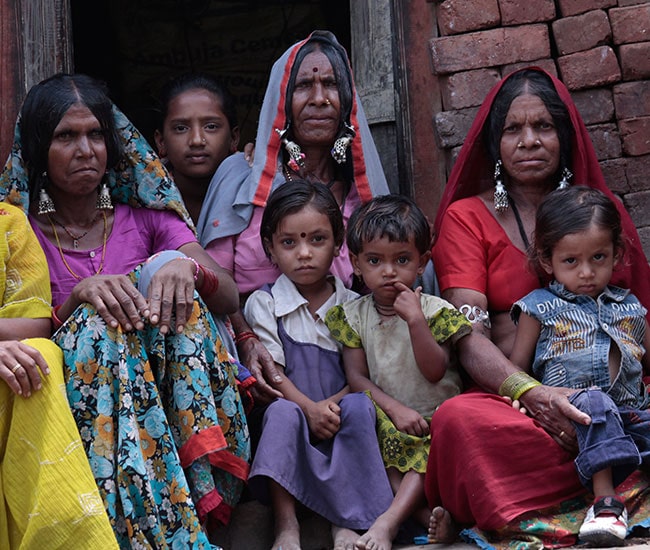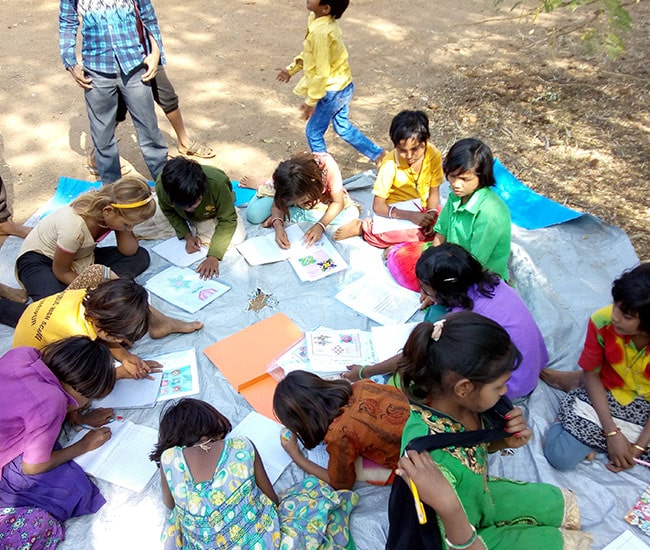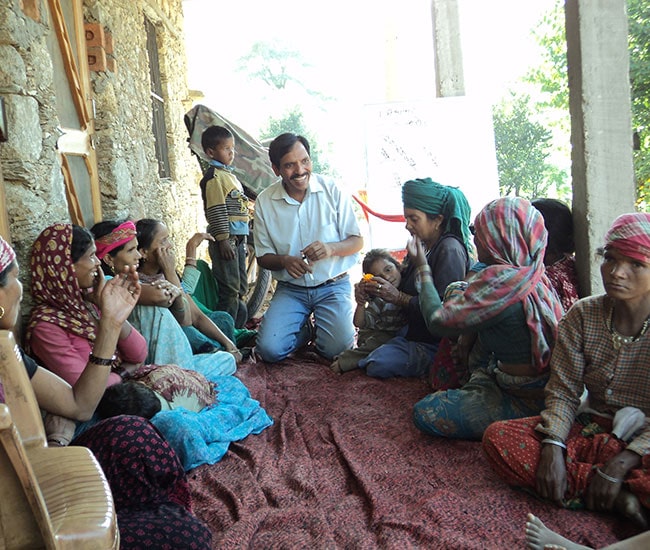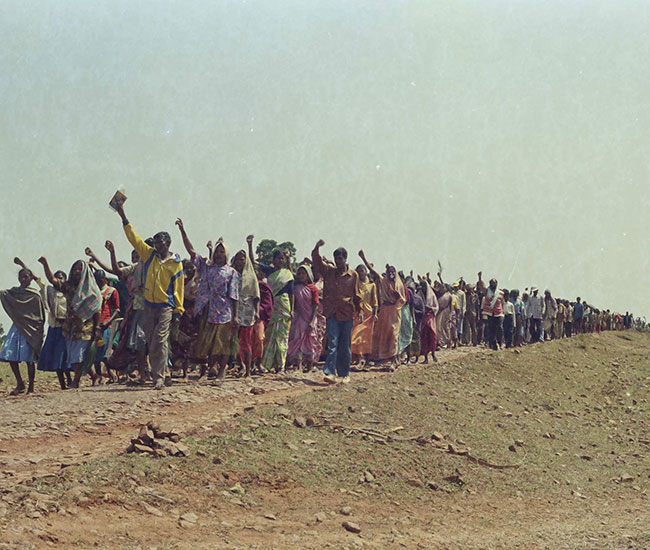
Bahishkrit Hitkari Sangathan
Background
Located in North Central Bihar, Khagaria is one of the most deprived districts in the state of Bihar. Ganga, Kosi and Bagmati are the main rivers flowing through the district, making the land extremely fertile but also prone to floods. A thick forest cover in the area acts as a hideout for the Maoists. Due to the highly unequal land holding patterns, most people work as wage labour on fields, and migration to Delhi, Haryana and Punjab is a common feature. About 70 per cent of the population consists of Dalits and OBCs. The caste system is a strong and oppressive presence in the region with women bearing the worst consequences of it. The upper caste, land owning Bhoomihars call the shots, and the practice of untouchability continues to be rampant.
Sangathan Profile
After having understood that the people from the Dom community were being ill treated because they fell outside the caste hierarchy, Sanjeev decided to work towards addressing the issues of untouchability and discrimination, and the Bahishkrit Hitkari Sangathan (BHS) was born in 2006. Currently, BHS works in the Khagaria, Katihar, Bhagalpur, Sheikhpura and most recently, Aurangabad districts. Most of the work is focussed in Khagaria. In Katihar, the sangathan is working with the people of the Musahar caste. In Bhagalpur and Sheikhpura, they work with both Doms and Musahars.
Traditionally, Doms were forced to do the jobs that no one else would. For example, they had to cremate dead bodies, clean the toilets of the people in the village, manage the dead bodies of animals etc. The intervention of the sangathan has meant that they no longer do these kinds of work. BHS also started a campaign against eating leftovers by conducting several meetings with the people and explaining to them what exactly leftover food was. Slowly, they understood and took a vow that they will not eat food that has been spat out by others. The Doms have now decided to abandon the age old tradition of eating leftovers from the marriages and functions.
The condition of the Musahars was even worse. They lead a hand to mouth existence and are called Musahars because extreme poverty has led them to eat even mice. Most of them live close to the river banks and hence the floods displace them every year. BHS is beginning to work with them too, and encouraging them to live with dignity.
When Sanjeev initially moved back to his village, he realized that the greatest drawback of the Doms was their lack of education. So he gathered the Dom children in a house and taught them to read and write for about 2-3 hours everyday. He also made efforts to improve their hygiene. Later, after BHS was formed, work on education continued in full earnest, and the children who Sanjeev was teaching were enrolled in schools. This was of great significance since many of them were the first from their families to have stepped into schools. There were protests from higher caste parents, and the teachers too often neglected these students. Their fear was that if these children got educated and got good jobs, then it will not be possible to practise untouchability, and that would signal the end of their own dominance in society.
Along with the children, Sanjeev also started having classes for the women. But the men in the villages did not like the idea of the women getting educated, for that meant they would begin to question the men. Sanjeev ran the school in a make shift structure for three years before it was struck down by the men. One of the karyakartas of the sangathan, Rekha, continues to teach women in the village of Temtharakha. [Rekha Story]
Education of women has led to their rejecting oppressive practices, right from being paid extremely low wages for their labour, to being abducted at will by the feudal lords. [Atrocities against Women] Today, women have a strong presence in the sangathan, with 5,000 of its members and half of its 12 person core group being women. They take their own decisions and put up a strong fight against age old practices of oppression.
One of the key initiatives of BHS has been the Bahishkrit Chetna Mela, whereby women from the backward communities collect water from the Ganga and then congregate for a meeting and awareness camp. The number of the participating women has been increasing, with even Muslim women from the neighbouring district of Bhagalpur joining in the Mela.
Changes are slowly becoming visible in the society. The backward castes have conducted their own elections, and its office bearers have newfound respect from the entire society. [Self-Rule] Upper castes are facing resistance from the Dalit community, but this resistance has come at a price. Sanjeev was forced to leave his forefather’s village in Khagaria and his cousin was killed in an attempt to intimidate Sanjeev and stop him from doing his work with the backward castes. The sangathan also has to face the wrath of the Naxalites, as they opine that the BHS is preventing the youth from taking up arms and joining their cadre by providing an alternative.
Current Work
During the Bhoodan Movement, many deprived and landless families were promised land, but it did not get transferred in their name. So BHS has taken up this issue to claim a house and arable land for those entitled to them. They are now getting children to be a part of this campaign—they will demand land so that their fathers can work on it thereby enabling them to go to school.
Focus has also turned towards education since 2010, when the Right to Education Act was passed. Buildings have been built as schools but children do not receive any education. The sangathan is raising its voice against the violation of the Act both in letter and in spirit.
BHS is attempting to make the village of Sirajpur an ideal one, and the process has led to getting 13 government schemes implemented in the village. [Claiming Entitlements]
The sangathan is also engaged in the process of getting more people in their fold through a membership campaign. People can become a part of the sangathan by paying Re 1, and there are about 10,000 members now, the numbers growing day by day.
Stories
Rekha Story
Rekha Devi was raised as a city girl in Parbatta. Her father had a good job, and she her sisters had a comfortable childhood in a huge house. Although they belonged to the backward Kanu caste, they never felt much discrimination while growing up in the town. Her life changed when her family bowed down to social norms and got her married just before she turned 18.
When she arrived in Noronga village after getting married, she was shocked to find that she had been lied to. The financial condition of her in laws was very bad. Her husband who was much older to her, worked as a daily wage labourer, and soon she had to soon join him, even during her pregnancy. She went through many difficult years as she shuttled between her maternal and marital home, lack of money pushing her in one direction, and societal pressure pushing her in the other. During one of these trips, Rekha met Sanjeev, who heard her story. She seemed to be someone who could work with other women. Sanjeev decided to make her the teacher of the school where he was teaching women. That decision surely helped bring more women to school—they could connect with her, at the same time, they felt that she was empowered because she was educated.
“More and more women began to come to me with their problems. I could not solve them but they were happy that I was listening. At the same time, teaching the women to read and write took my mind off my miseries,” says Rekha. She is now an integral part of BHS, and actively participates in everything, right from the planning of meetings to encouraging women to be steadfast in opposing any kind of repression or violence against them.
Atrocities against Women
The oppression against women has been caste and gender based. Hunger and fear would lead women to surrender themselves to the rich landlords for an extra handful of grain. Rape was an unspoken of crime, perpetrated by the feudal lords. In 2006, BHS took up the case of a woman on whom rape was attempted. They soon realised that if the case was taken to the cops and the courts, the culprit would be released, and the woman would be forced to turn hostile. So about 100-150 women went to that man’s village, surrounded his house and began to hurl shoes and stones, and also spit on his house. They made a lot of noise and ensured that he lost face in society. Then the culprit was called to the Panchayat where he held his ears and begged pardon. This had made quite an impact amongst the people. Because the sangathan highlighted such cases, people from the lower castes began to feel that indeed their lives also mattered, and that nobody ought to touch them. They felt strong enough to discuss these matters and protest against atrocities.
Another issue that the sangathan took up was of the children in the region who are mostly fathered by the higher caste men. These men would threaten the lower caste families and make them give the girls and women for a night. BHS faced much opposition from the higher castes, because they were exposing the fact that the women from the Dom community were their wives for the night but were untouchables during the day. These men would not give their name to the child they fathered, nor could the child address them as their father. Now following the intervention by the sangathan, the men from the higher castes have stopped forcing the lower caste women to be with them for the night.
Bahishkrit Chetna Mela
The idea of the Ganga Kalash Yatra is to counter the stronghold of the upper castes on everything, including rituals. Sanjeev sees it as a major symbol of peaceful revolution within the society. In the past, Doms did not have the right to access the main river Ganga, and were allowed to use only its tributary. In 2006, BHS started the Bahishkrit Chetna Mela in which women of backward castes, in a move to challenge the practice of untouchability, collected water for the ritual from the main river. The first year, many women did not participate as they were afraid to go against tradition, but 175 women gathered for the programme. The event was well covered by the media and became a landmark, and has been carried out off and on over the next few years.
A month prior to the day of the Mela, one of the karyakartas from the Kumhaar (potter) community and her family gets involved in making earthen pots. Once made, they are then painted with limestone, a process that gets all the women involved. The next morning, at Aguwani ghat of the Ganga, the women bathe and then collect the water in their pots and walk about 7 kms to Parbatta town. The entire town wakes up to this spectacle. Once the women have reached the venue of the Mela, they participate in the meetings and activities. The opportunity is used to convey people’s issues to the representatives of the administration, and this is followed by a debate on the promises offered by the administration. A mini camp of all the departments of the administration, like health, aanganwadi, Indira Awas Yojna, NREGA, etc., are set up, where people’s complaints can be redressed. The event ends the next day, with women taking the pots and throwing them in the river. The karyakartas of BHS and the women take a vow that they will not be oppressed in the coming year.
In 2011 women from 17 backward castes participated. There were people from the Scheduled Castes (SC) like Dom, Chamaar, Musahar, Rajak; and from Other Backward Castes (OBC) like Kanu, Kamaar, Dhanuk, Yadav, Mali, Baheli, Naai, Teli, Baniya, Julha, Kumhar, Teeyar, Koyri and there were Muslims. In all, 1011 women were part of this significant event. This year, the Mela was presided by Shiv Malik, who is from the Chamaar community. The attempt has been to have someone from a backward caste sitting next to the minister on the dais and presiding over the meeting.
Self-Rule
After BHS was formed in 2006, the first district level meeting was held on June 19, 2006 for which about 700 people gathered together. Many senior and recognised people had promised to come, but none of them turned up because this was an event of the Dom people. So the Doms themselves inaugurated the function and began the programme. That gave the people enough confidence and made them realize that they need not rely on others.
Since they were never considered part of the mainstream system, they initiated their own elections. They made their own wards within the district, elected the mukhiya (head of village council) and sarpanch (village head). They managed to resolve local disputes through this system, rather than going to the police station or the courts. Each year, they have an election where they elect a president at the village, block and district levels.
The office bearers of this new panchayat are addressed according to the offices they hold, such as “Sarpanch jii” or “Mukhiya jii”. When the Doms began to address them with those titles, the people from the rest of the society also addressed them thus. So they began to feel a kind of dignity and self respect that they had never experienced before. However, not going to the established institutions like the police or courts is just a short term strategy till people feel confident enough to hold their own in those spaces.
Self-Rule
After BHS was formed in 2006, the first district level meeting was held on June 19, 2006 for which about 700 people gathered together. Many senior and recognised people had promised to come, but none of them turned up because this was an event of the Dom people. So the Doms themselves inaugurated the function and began the programme. That gave the people enough confidence and made them realize that they need not rely on others.
Since they were never considered part of the mainstream system, they initiated their own elections. They made their own wards within the district, elected the mukhiya (head of village council) and sarpanch (village head). They managed to resolve local disputes through this system, rather than going to the police station or the courts. Each year, they have an election where they elect a president at the village, block and district levels.
The office bearers of this new panchayat are addressed according to the offices they hold, such as “Sarpanch jii” or “Mukhiya jii”. When the Doms began to address them with those titles, the people from the rest of the society also addressed them thus. So they began to feel a kind of dignity and self respect that they had never experienced before. However, not going to the established institutions like the police or courts is just a short term strategy till people feel confident enough to hold their own in those spaces.
Claiming Entitlements
The government has a Special Component Plan for the SCs, STs and OBCs, but just 17 per cent of the funds were being been used. BHS has been holding dialogues with the administration and this has helped in the proper implementation of many government schemes. The sangathan brought officials to the villages to get them to listen to the people and understand their issues. This process was done in Parbatta block where people’s individual and community issues were articulated, recorded and analysed. The people then began to knock the doors of officials at the block and district levels, and tell the administration that they too existed. Their names were thus included in the voter and BPL lists. People were given money to build their homes as per the Indira Awas Yojna, and allotted the arable land that they were entitled to. They were also given job cards to be eligible for getting work under NREGA.





